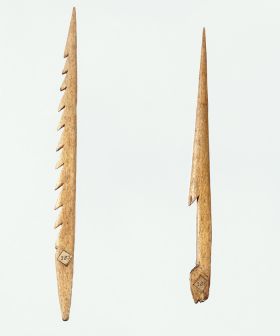Harpoon point kaheita
Place: Nootka
Category: Fishing & hunting
Harpoon point kaheita, bone, Nootka Sound, northern Pacific, l. 33.5 cm, Inv. Am 643 (left)
Harpoon (?) point, (Cook: Kaheita), Inv. Am 643
Humphrey No. 283: ‘Head or point of a fish-spear with many barbs, made of the bone of some large marine animal, from King George’s Sound, N. W Coast of America.’
Lance-shaped point made of whale (?) bone, one side with ten barbs from acute-angled notches (an eleventh is unfinished). The lower end is somewhat blunted. There are no traces of a fastening device.
Humphrey identified the piece as the point of a fish-spear from the bones of a large marine mammal, and listed King George’s Sound (Nootka Sound) as the provenance. In the cataloguing, the object was identified by reference to Koppers (1924: 100, Fig. 17) as from Tierra del Fuego. This classification is incorrect however.
The only comparable piece (in a wider sense) from other collections from the third voyage is to be found in Florence. This piece is somewhat shorter, with only two barbs, but at the lower end with a harpoon line made of sinews, with which a piece of bone is affixed. This, together with the lower end of the point, forms a support for the front end of the harpoon shaft (Kaeppler 1978b: 163f.). Sarah Stone illustrated two examples comparable to the Florence piece, of which one has one barb, the other three (Force and Force 1968: 160). A similar piece from the third voyage may also be found in Edinburgh, in which a bone point with two barbs is mounted and cemented to two bone pieces, in a similar manner to that of the mussel shell points described earlier (Kaeppler 1978a: 275, Fig. 607). Ellis (1783, I: 221) described this type of point (with two barbs) as that of a harpoon for whaling. Cook commented upon the designation ‘Kaheita’ thus: ‘A barbed bone joint to strike seals & ca’ (Beaglehole 1967, IIIa: 325).
Archaeological finds from the coastal regions of British Columbia and the northern part of Washington State confirm the presence of long, lance-shaped bone points with a large number of similar or identical barbs along one side. These were evidently used in little-changed form over several millennia until historic times (e.g., Fladmark 1986: 95, 99; Kirk and Daugherty 1978: 35; Carlson o.J.: 20, 31, Fig. 1: 3, 8).
Drucker’s informants described harpoons with similar points in connection with seal hunting and described as an ‘old type’ a form of dart, the slender, detachable point of which was serrated on one (or both?) sides, and fastened to the shaft with a cord (Drucker 1951: 27). Christian F. Feest
Sources
Beaglehole, John Cawte, The Journals of Captain James Cook on his Voyages of Discovery The Voyage of the Resolution and Discovery 1776-1780, Hakluyt Society, Extra Series, 36, 1 u. 2. vol. 3, Cambridge University Press, Cambridge, 1955-1967 IIIa and IIIb.
Carlson, Roy L, ‘Prehistory of the Northwest Coast’, in Roy L Carlson (ed.), Indian Art Traditions of the Northwest Coast, Burnaby, n.d., pp. 13-32.
Drucker, Philip, The Northern and Central Nootka Tribes, Bulletin 144, Bureau of American Ethnology, Smithsonian Institution, Washington, DC, 1951.
Ellis, William, An Authentic Narrative of a Voyage by Captain Cook and Captain Clerke..., [1782], London, 1783.
Fladmark, Knut R, British Columbia Prehistory, Ottawa, 1986.
Force, Roland and Force, Maryanne, Art and Artifacts of the Eighteenth Century, Honolulu, 1968.
Kaeppler, Adrienne L, ‘Artificial Curiosities’ Being An Exposition of Native Manufactures Collected on the Three Pacific Voyages of Captain James Cook RN [Exhibition catalogue], Bishop Museum Press, Honolulu, 1978a.
Kaeppler, Adrienne L, Cook Voyage Artifacts in Leningrad, Berne and Florence Museums, Bishop Museum Press, Honolulu, 1978b.
Kirk, Ruth and Daugherty, Richard D, Exploring Washington Archaeology, Seattle and London, 1978.
Koppers, Wilhelm, Unter Feuerland-Indianern, Stuttgart, 1924.
Related artefacts
Harpoon or lance point, Inv. Am 47

